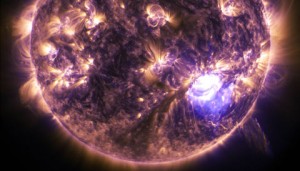
Credit: NASA / SDO / Duberstein
What is a solar flare? Featured in our November 2015 issue, flares are spikes in emission from the Sun, energy unleashed (we’re fairly sure) when magnetic field lines suddenly reconnect. But astronomers don’t agree on the specifics of how they work — just check out this library of solar flare “cartoons”!
Solar flares come in a range of flavors, and scientists classify flares based on their X-ray intensity. These classes are A, B, C, M, and X, with A being the weakest and X the strongest. These letters correspond to an intensity scale:
A = 1.0x10-8 watts/m2
B = 1.0x10-7 watts/m2
C = 1.0x10-6 watts/m2
M = 1.0x10-5 watts/m2
X = 1.0x10-4 watts/m2
Each lettered category is also subdivided, based on the exact value of the flare’s intensity — such as C3, X1.8, and so forth. So to determine a flare’s intensity, you multiple the intensity of the class by the subdivision number. For example, an X3 flare has an intensity of (1.0x10-4)×(3)=3x10-4 watts/m2. (Info taken from the Living With a Star project page.)
Strong flares can also lead to radio blackouts and coronal mass ejections, or CMEs (CMEs are, in fact, not the same thing as a flare). And they’re just darn cool to watch. Check out this flare that the Sun released in December 2014, shown in various wavelengths (hence the different colors):
Credit: NASA Goddard Space Flight Center
And this video (also from NASA Goddard) really conveys just how complex and marvelous the Sun is. The video shows a 200,000-mile-long magnetic filament erupting on September 29-30, 2013, using satellite data taken on those days. (Yes, these images are real.) The glowing “canyon of fire” traces the channel where magnetic fields had held the filament aloft before the explosion.
Credit: NASA Goddard Space Flight Center
The largest flare we’ve seen in modern times happened in 2003, but fortunately it wasn’t pointed at Earth. Still, eruptions from the same sunspot group (AR 10486) that unleashed that flare created the so-called Halloween auroral storm, which lit up Earth’s skies down to Florida. This video recorded by SOHO's LASCO C3 instrument shows CMEs expanding outward from the Sun and striking SOHO's CCD recorders, creating a snow-like pattern. These CMEs were associated with significant solar flares release on October 28, 2003 (X17.2 flare), October 29, 2003 (X10 flare), and November 4, 2003 (X28, maybe — the flare was pointed away from Earth and so powerful that it surpassed measurements). The object seen moving from right to left in the video below is the planet Mercury.
Credit: ESA & NASA / SOHO
 0
0

Comments
You must be logged in to post a comment.